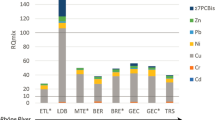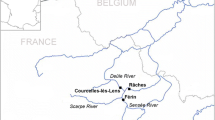Abstract
While it has been well established that sediment bioturbators can affect the fate of metals in aquatic systems and that the fate of metals there can depend on sediment characteristics, the interaction between these influences is not well known. The present study therefore investigated whether the influence of a sediment bioturbator on the fate of metals is affected by sediment characteristics. This was investigated using two laboratory microcosm experiments with lead-contaminated sediment and the oligochaete Lumbriculus variegatus. The first experiment used sediment collected from five Toledo Bend reservoir sites that differed in sediment characteristics, and analyses looked at the influence of sediment organic matter, sediment silt/clay content, sediment pH, and pore-water pH. In the second experiment, organic matter and silt/clay content of Toledo Bend reservoir sediment were varied experimentally using alpha-cellulose and clay, and Pb transfer to the water column and bioaccumulation were again quantified. Both experiments were conducted with sediment spiked with Pb to a concentration of 100 µg/g, at an oligochaete density of 6279 ind./m². In the first experiment, the Pb concentrations in the water column and those in the worms at the end of the 14-day experiment differed among sediment-collection sites. Silt/clay content and sediment pH were the two most important variables influencing Pb transfer from sediment to the water column. A multiple regression model with these variables explained 58% of the variability in this lead transfer. For Pb accumulation by the worms, sediment organic matter and pore-water pH were the two most important variables. This regression model explained 85% of the variability in tissue Pb levels. In the second experiment, where the individual effects of the organic matter and silt/clay content on Pb transport and distribution were assessed, the use of sediment with more organic matter resulted in a reduction in both the Pb transfer to the water column and the accumulation in worms. The increase in the sediment’s silt/clay content resulted in a reduction in Pb bioaccumulation only. Overall, the results of the present study demonstrate that sediment pH, pore-water pH, organic matter, and silt/clay content influence the bioturbation-mediated transfer and the environmental distribution of Pb.



Similar content being viewed by others
References
Allen HE (1995) Metal contaminated aquatic sediments. Ann Arbor Press, Chelsea, MI
Ankley GT, Di Toro DM, Hansen DJ, Berry WJ (1996) Technical basis and proposal for deriving sediment quality criteria for metals. Environ Toxicol Chem 15:2056–2066
Back H (1990) Epidermal uptake of Pb, Cd, and Zn in tubificid worms. Oecologia 85:226–232
Besser JM, Brumbaugh WG, May TW, Ingersoll CG (2003) Effects of organic amendments on the toxicity and bioavailability of cadmium and copper in spiked formulated sediments. Environ Toxicol Chem 22:805–815
Bianchi TS (2007) Biogeochemistry of estuaries. Oxford University Press, New York, NY
Blankson ER, Klerks PL (2016a) The effect of bioturbation by Lumbriculus variegatus on transport and distribution of lead in a freshwater microcosm. Environ Toxicol Chem 35:1123–1129
Blankson ER, Klerks PL (2016b) The effect of lead from sediment bioturbation by Lumbriculus variegatus on Daphnia magna in the water column. Ecotoxicology 25:1712–1719
Campana O, Blasco Jn, Simpson SL (2013) Demonstrating the appropriateness of developing sediment quality guidelines based on sediment geochemical properties. Environ Sci Technol 47:7483–7489
Campana O, Simpson SL, Spadaro DA, Blasco Jn (2012) Sub-lethal effects of copper to benthic invertebrates explained by sediment properties and dietary exposure. Environ Sci Technol 46:6835–6842
Camusso M, Polesello S, Valsecchi S, Vignati DA (2012) Importance of dietary uptake of trace elements in the benthic deposit-feeding Lumbriculus variegatus. TrAC, Trends Anal Chem 36:103–112
Chapman PM, Farrell MA, Brinkhurst RO (1982) Relative tolerances of selected aquatic oligochaetes to individual pollutants and environmental factors. Aquat Toxicol 2:47–67
Ciutat A, Anschutz P, Gerino M, Boudou A (2005) Effects of bioturbation on cadmium transfer and distribution into freshwater sediments. Environ Toxicol Chem 24:1048–1058
Ciutat A, Boudou A (2003) Bioturbation effects on cadmium and zinc transfers from a contaminated sediment and on metal bioavailability to benthic bivalves. Environ Toxicol Chem 22:1574–1581
Cook DG (1969) Observations on the life history and ecology of some Lumbriculidae (Annelida, Oligochaeta). Hydrobiologia 34:561–574
Davis WR (1993) The role of bioturbation in sediment resuspension and its interaction with physical shearing. J Exp Mar Biol Ecol 171:187–200
De Jonge M, Blust R, Bervoets L (2010) The relation between acid volatile sulfides (AVS) and metal accumulation in aquatic invertebrates: Implications of feeding behavior and ecology. Environ Pollut 158:1381–1391
Gilbert F, Hulth S, Grossi V, Poggiale J-C, Desrosiers G, Rosenberg R, Gérino M, François-Carcaillet F, Michaud E, Stora G (2007) Sediment reworking by marine benthic species from the Gullmar Fjord (Western Sweden): importance of faunal biovolume. J Exp Mar Biol Ecol 348:133–144
Hoffman DJ, Rattner BA, Burton Jr GA, Cairns Jr J (1995) Handbook of ecotoxicology. Lewis, Ann Arbor, MI
Horowitz AJ (1991) A primer on sediment-trace element chemistry, 2nd edn. Lewis, Chelsea, MI
Kelderman P, Osman A (2007) Effect of redox potential on heavy metal binding forms in polluted canal sediments in Delft (The Netherlands). Water Res 41:4251–4261
Labrot F, Narbonne J, Ville P, Saint Denis M, Ribera D (1999) Acute toxicity, toxicokinetics, and tissue target of lead and uranium in the clam Corbicula fluminea and the worm Eisenia fetida: comparison with the fish Brachydanio rerio. Arch Environ Contam Toxicol 36:167–178
Leonard EN, Mount DR, Ankley GT (1999) Modification of metal partitioning by supplementing acid volatile sulfide in freshwater sediments. Environ Toxicol Chem 18:858–864
Lin J-G, Chen S-Y (1998) The relationship between adsorption of heavy metal and organic matter in river sediments. Environ Int 24:345–352
MacDonald DD, Ingersoll C, Berger T (2000) Development and evaluation of consensus-based sediment quality guidelines for freshwater ecosystems. Arch Environ Contam Toxicol 39:20–31
Morse JW (1994) Interactions of trace metals with authigenic sulfide minerals: implications for their bioavailability. Mar Chem 46:1–6
Pattee OH, Pain DJ (2003) Lead in the environment. In: Hoffman DJ, Rattner BA, Burton Jr GA, Cairns Jr J (eds) Handbook of ecotoxicology. CRC, Boca Raton, pp 373–399
Peterson GS, Ankley GT, Leonard EN (1996) Effect of bioturbation on metal‐sulfide oxidation in surficial freshwater sediments. Environ Toxicol Chem 15:2147–2155
Phipps GL, Ankley GT, Benoit DA, Mattson VR (1993) Use of the aquatic oligochaete Lumbriculus variegatus for assessing the toxicity and bioaccumulation of sediment‐associated contaminants. Environ Toxicol Chem 12:269–279
Phipps GL, Mattson V, Ankley G (1995) Relative sensitivity of three freshwater benthic macroinvertebrates to ten contaminants. Arch Environ Contam Toxicol 28:281–286
Rasmussen AD, Banta GT, Andersen O (2000) Cadmium dynamics in estuarine sediments: Effects of salinity and lugworm bioturbation. Environ Toxicol Chem 19:380–386
Remaili TM, Simpson SL, Amato ED, Spadaro DA, Jarolimek CV, Jolley DF (2016) The impact of sediment bioturbation by secondary organisms on metal bioavailability, bioaccumulation and toxicity to target organisms in benthic bioassays: implications for sediment quality assessment. Environ Pollut 208:590–599
Simpson SL, Apte SC, Batley GE (1998) Effect of short-term resuspension events on trace metal speciation in polluted anoxic sediments. Environ Sci Technol 32:620–625
Strom D, Simpson SL, Batley GE, Jolley DF (2011) The influence of sediment particle size and organic carbon on toxicity of copper to benthic invertebrates in oxic/suboxic surface sediments. Environ Toxicol Chem 30:1599–1610
USEPA (2000) Methods for measuring the toxicity and bioaccumulation of sediment: associated contaminants with freshwater invertebrates. USEPA-US Environmental Protection Agency, Washington, DC
Vulkan R, Zhao F-j, Barbosa-Jefferson V, Preston S, Paton GI, Tipping E, McGrath SP (2000) Copper speciation and impacts on bacterial biosensors in the pore water of copper-contaminated soils. Environ Sci Technol 34:5115–5121
Wang W-X, Guo L (2000) Influences of natural colloids on metal bioavailability to two marine bivalves. Environ Sci Technol 34:4571–4576
Wetzel RG (1992) Gradient-dominated ecosystems: sources and regulatory functions of dissolved organic matter in freshwater ecosystems. In: Salonen K, Kairesalo T, Jones RI (eds) Dissolved organic matter in lacustrine ecosystems. Springer, Netherlands, pp 181–198
Acknowledgements
We thank the Graduate Student Organization of the University of Louisiana at Lafayette for funding (provided to ERBs), A. Billock, A. Oguma, J. Adeyemi, and J. Farmer for assistance with laboratory and field work, and D. Felder for advice on study design.
Author information
Authors and Affiliations
Corresponding author
Ethics declarations
Conflict of interest
The authors declare that they have no competing interests.
Rights and permissions
About this article
Cite this article
Blankson, E.R., Klerks, P.L. The effect of sediment characteristics on bioturbation-mediated transfer of lead, in freshwater laboratory microcosms with Lumbriculus variegatus . Ecotoxicology 26, 227–237 (2017). https://doi.org/10.1007/s10646-016-1757-0
Accepted:
Published:
Issue Date:
DOI: https://doi.org/10.1007/s10646-016-1757-0




